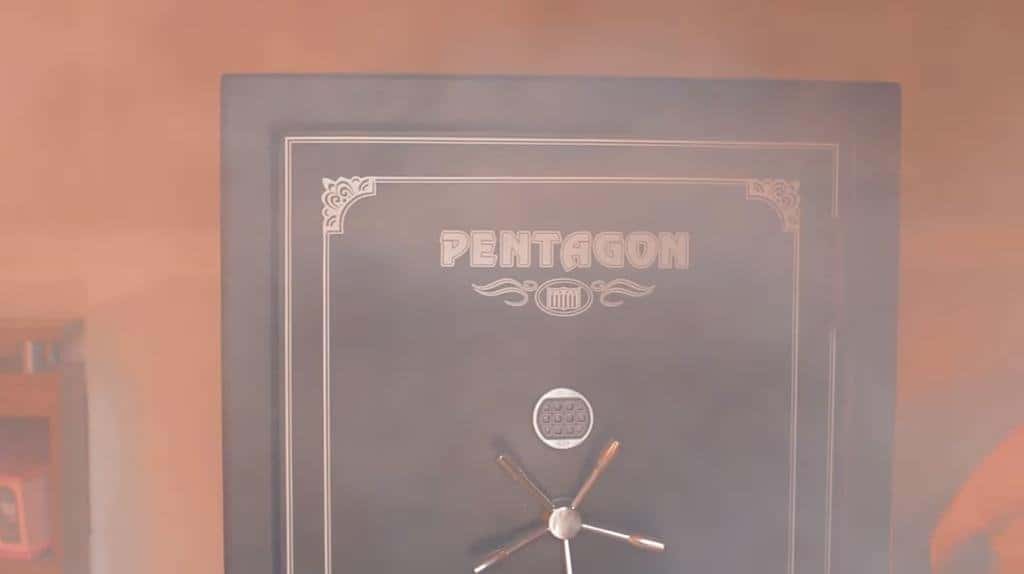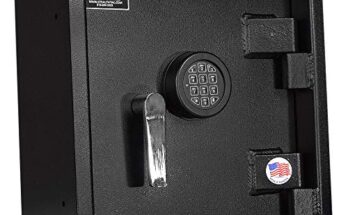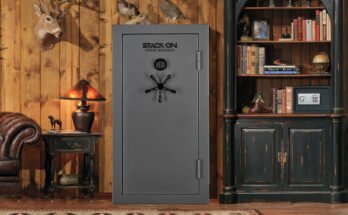A gun safe is essentially used to offer maximum protection of valuable documents, handguns, and other expensive items. In most cases, most gun owners fail to fireproof their gun safe because they presume it has already been fireproof by the manufacturer. What if your valuable items in the safe get destroyed by fire?
And, so, it is always important to check whether your gun safe is fireproof or not. If your safe is not fireproof, it is something you can do yourself without the help of the manufacture. However, when fireproofing your gun safe, you ought to take necessary precautions because of the sensitive content in the safe. Additionally, you can purchase thick sheets of heat-proofing insulator material to protect your safe from unnecessary damages.
In this article, we’ve done in-depth research and compiled a detailed step-by-step guide to fireproof a gun safe effortlessly. Continue reading to find more about fireproofing a gun safe.
Here is How You Can Fireproof Your Gun Safe:
1. Check the safe fire protecting rating
Fireproofing a gun safe is a daunting task that needs serious scrutiny. It is not easy to pass your safe to any form of heat, considering the sensitive content embodied in the safe. So, before you purchase your gun safe; it is recommended to check the materials used to fireproof the gun safe.
Similarly, the fireproof rating of a safe will always determine the ability of the safe to tolerate higher heat. Thus, fireproofing ought to be approximately 30 minutes to secure the sensitive content safe from damages or burning.
Additionally, you will be compelled to deem fit the materials used to make your house/home. This is because when your home suddenly hits the fire, your gun safe ought to protect your valuable items no matter the condition.
2. Locate a suitable place for your Safe
Keeping your gun safe from fire is not the only solution here. However, the basement of your gun safe will matter a lot when a fire strikes your home. Therefore, locating the best place to fireproof your safe gun is the most important step to deem fit.
So, it is advisable to keep your gun safe on a slab floor or concrete. These are not flammable areas. Therefore, they will ultimately help to prevent fire from spreading. Nonetheless, if you don’t have a good place to locate your safe gun, you should keep it safe and in an isolated area to prevent children and visitors from accessing it.
Also, you should avoid placing your safe on weak floors or wooden floors and places that are easily vulnerable. Moreover, you should not install the gun safe in areas like garages, hallways, and stairs because they has the heat-prune material.
3. Use the flame retardant insulator
Normally, insulators become the best option since they assist in maintaining the normal temperature inside a gun safe, particularly when they’re used inside. And so, you have to ensure your gun safe is properly insulated to keep the temperature levels under control in case of a fire outbreak.
Examine your insulation to see to it that it is intact within the safe. However, in case of any problem, you can use a hacksaw to cut the insulation so that it can fit well when glued on the safe’s wall.
In the same vein, you’d want to ensure the insulation you are using is flame-resistant to prevent failure. In addition, you can as well use gypsum board, drywall, and more to make the exterior part of your gun safe. Gypsum board is considered the best flame retardant insulator to use as the exterior part of the safe.
Moreover, what makes gypsum a good insulator is its inclusion of hydrates. These compounds are released as steam when a lot of heat is applied, thus, serving as good flame resistance. Additionally, you can use the next step in case you fail to access a flame retardant insulator.
4. Cover the safe with a soft mat or carpet
Covering your safe with a soft mat or carpet essentially helps to prevent your safe from corrosion, where the bottom surface of your gun safe will start to corrode quickly. So, before you cover your safe with carpet, ensure it is moisture-free by inserting a blanket where the safe lies.
Similarly, this method protects your safe from other harmful chemical that might trigger a reaction from the safe.
5. Remove flammable objects inside your safe
Flammable items around it will always attract fire. So, to make your gun safe fireproofing, you have to do away with any flammable object around your safe. You can store them in a different place far from your gun safe to avoid fuel or fire damages.
Moreover, it is recommended that your gun safe has a UL rating of above 125 degrees F. The high UL rating in the safe primarily helps prevent the high temperature from within the safe that might cause harm inside the gun safe.
6. Build roll-out drawers
This is another step of fireproofing your gun safe. Drawers are important tools that can help you store different types of handguns. Therefore, install roll-out drawers to offer you space and keep your weapons away from any flammable material. Keep in mind the different firearms such as handguns, hunting rifles, and shotguns that might need different storage.
Why do I need to fireproof my gun safe?

Fireproofing your gun safe helps to protect firearms and valuable items inside from damage in case of a fire. It helps ensure that your firearms remain in good condition and maintain their functionality.
Fireproofing your gun safe is essential for several important reasons:
- Protection of Firearms: Firearms can be valuable investments, and they are susceptible to damage in a fire. Fireproofing your gun safe ensures that your firearms remain intact and functional, preserving their value.
- Safety of Ammunition: Ammunition can become unstable and dangerous if exposed to high temperatures in a fire. A fireproof gun safe helps contain and protect ammunition, reducing the risk of explosions or accidents.
- Preservation of Important Documents: Many gun safes are used to store not only firearms but also important documents like passports, deeds, and legal papers. Fireproofing safeguards these critical documents from being destroyed in a fire.
- Peace of Mind: Knowing that your firearms and valuables are protected from fire damage provides peace of mind. In the event of a fire, you can focus on ensuring the safety of your family rather than worrying about the loss of firearms and important possessions.
- Compliance with Insurance Requirements: Some insurance policies require that firearms be stored in fireproof safes to be covered in case of fire-related damage. Fireproofing your gun safe can help you comply with insurance requirements and ensure you receive compensation for any losses.
- Responsible Ownership: Fireproofing your gun safe is part of being a responsible firearm owner. It demonstrates your commitment to firearm safety and the protection of your community by preventing firearms from falling into the wrong hands in the event of a fire or theft.
- Maintaining Functionality: Even if firearms survive a fire without visible damage, exposure to high temperatures can affect their functionality and accuracy. Fireproofing safeguards your firearms’ performance.
- Preserving Sentimental Items: In addition to firearms, gun safes often contain sentimental items like heirlooms and family keepsakes. Fireproofing helps ensure that these irreplaceable items are not lost in a fire.
In summary, fireproofing your gun safe is a responsible step to protect your firearms, valuables, and important documents from the devastating effects of a fire. It safeguards your investments, ensures compliance with insurance requirements, and contributes to overall firearm safety.
What materials are commonly used to make fireproof gun safes?
Fireproof gun safes are constructed using a combination of fire-resistant materials that can withstand high temperatures and protect the contents from fire damage. Commonly used materials include:
- Fireboard (Gypsum Board): Fireboard, often made of gypsum, is a common material used in the construction of fireproof gun safes. It has excellent fire-resistant properties and is used to line the interior walls, ceiling, and door of the safe. The thickness and quality of the fireboard can vary between different safes.
- Ceramic Fiber Insulation: Ceramic fiber insulation is another material used to enhance the fire resistance of gun safes. It is highly effective at insulating against heat and is often added as additional layers within the safe.
- Composite Fire Insulation: Some gun safes use a composite fire insulation material, which can include a mix of fireboard, ceramic fiber, and other fire-resistant substances. This composite insulation provides a higher level of protection against extreme temperatures.
- Fireproof Seals and Gaskets: Fireproof gun safes may feature heat-resistant seals and gaskets around the door to prevent smoke and flames from entering the safe. These seals help maintain a lower internal temperature during a fire.
- Steel Layers: While steel is not inherently fireproof, many gun safes have thick steel walls and doors that can withstand exposure to fire for a certain period. The combination of steel and fire-resistant materials enhances the overall fire protection.
- Fire-Resistant Coatings: Some safes are coated with fire-resistant paint or outer layers that provide an additional level of protection against heat and flames.
- Reinforced Door Construction: The door of a gun safe is often the most vulnerable part in terms of fire resistance. Many large safes have reinforced door construction with additional layers of fire-resistant materials and steel to protect the contents.
The specific combination and thickness of these materials can vary between different models and brands of gun safes. When choosing a fireproof gun safe, it’s essential to consider the overall fire rating, which indicates the safe’s ability to withstand fire for a specified period at a certain temperature. Higher-rated safes can protect your firearms and valuables for longer periods in case of a fire.
How does fireproofing work in a gun safe?
Fireproofing in a gun safe works by creating a barrier of fire-resistant materials that can withstand high temperatures, thereby protecting the contents of the safe from the damaging effects of fire. Here’s how fireproofing in a gun safe typically functions:
- Insulating Layers: Fireproof gun safes are constructed with multiple layers of fire-resistant materials, such as fireboard (often made of gypsum), ceramic fiber insulation, and composite fire insulation. These layers serve as a thermal barrier, slowing down the transfer of heat from the external environment to the inside of the safe.
- Reflecting and Absorbing Heat: The fire-resistant materials in the safe are chosen for their ability to reflect and absorb heat. When exposed to fire, these materials absorb the heat energy and release it slowly, preventing rapid temperature increases inside the safe.
- Maintaining a Lower Internal Temperature: The primary goal of fireproofing is to maintain a lower and more stable internal temperature within the safe while the external temperature rises due to the fire. By doing so, the contents of the safe are shielded from the extreme heat that could otherwise cause damage or destruction.
- Fire-Resistant Seals: Many fireproof gun safes include fire-resistant seals and gaskets around the door. These seals help create an airtight or smoke-tight barrier, preventing the intrusion of hot gases and smoke from the outside, which can further protect the contents.
- Steel Reinforcement: While fire-resistant materials are crucial, many gun safes also have thick steel walls and doors. While steel is not inherently fireproof, it provides structural integrity and can slow down the transfer of heat.
- Fire Ratings: Fireproof gun safes are assigned fire ratings based on their ability to withstand a fire for a specified duration (e.g., 30 minutes, 60 minutes, 90 minutes) at a certain temperature (e.g., 1200°F or 1400°F). The fire rating indicates the safe’s performance under fire conditions and is a key factor in determining its effectiveness in protecting contents during a fire.
It’s important to note that no gun safe is entirely impervious to fire, but fireproofing significantly increases the chances of preserving the contents during a fire emergency. When choosing a fireproof gun safe, consider the safe’s fire rating, construction materials, and other features to ensure it meets your specific needs for protecting firearms and valuable items in case of a fire.
What is the fire rating of a gun safe, and what should I look for?
The fire rating of a gun safe indicates the amount of time it can withstand a fire at a certain temperature before the internal temperature rises to a critical level. Look for safes with higher fire ratings, such as 30 minutes, 60 minutes, or more, depending on your needs.
How can I increase the fireproofing of my existing gun safe?
If you already have a gun safe and want to enhance its fireproofing, you can add fire-resistant insulation or fire-resistant blankets inside the safe. It’s also essential to keep the safe away from potential fire hazards.
Are all gun safes fireproof?
No, not all gun safes are fireproof. Fireproofing is a feature that varies among different safe models and brands. Look for safes specifically labeled as fireproof or fire-resistant.
What other precautions should I take to protect my firearms from fire damage?
In addition to using a fireproof gun safe, consider storing important documents and valuable items inside fireproof containers or safes. Also, have a fire escape plan and ensure you have working smoke detectors and fire extinguishers in your home.
Conclusion
Keeping your gun safe in a well-secure place is important because it prevents unwanted visitors and your children from accessing it. However, another step you can use to protect your gun safe is to fireproof it. Fireproofing your safe will be the ultimate solution in case of a fire outbreak in your home. When your gun safe is fireproofed, your valuable documents, including expensive items, might be secured from the damaging fire.
Therefore, to fireproof your gun safe, you can first check the safe fire protecting rating, locate a suitable place for your safe, use a flame retardant insulator, cover the safe with a soft mat or carpet and remove flammable objects inside your safe, and more.



